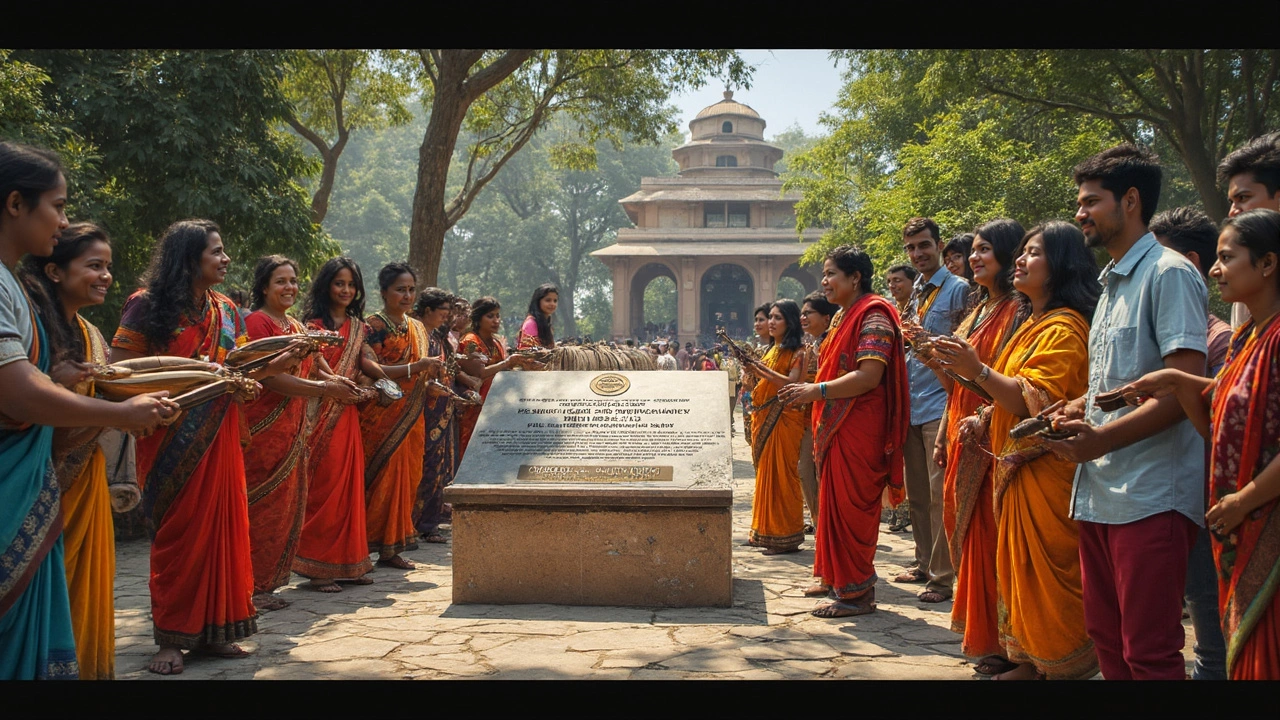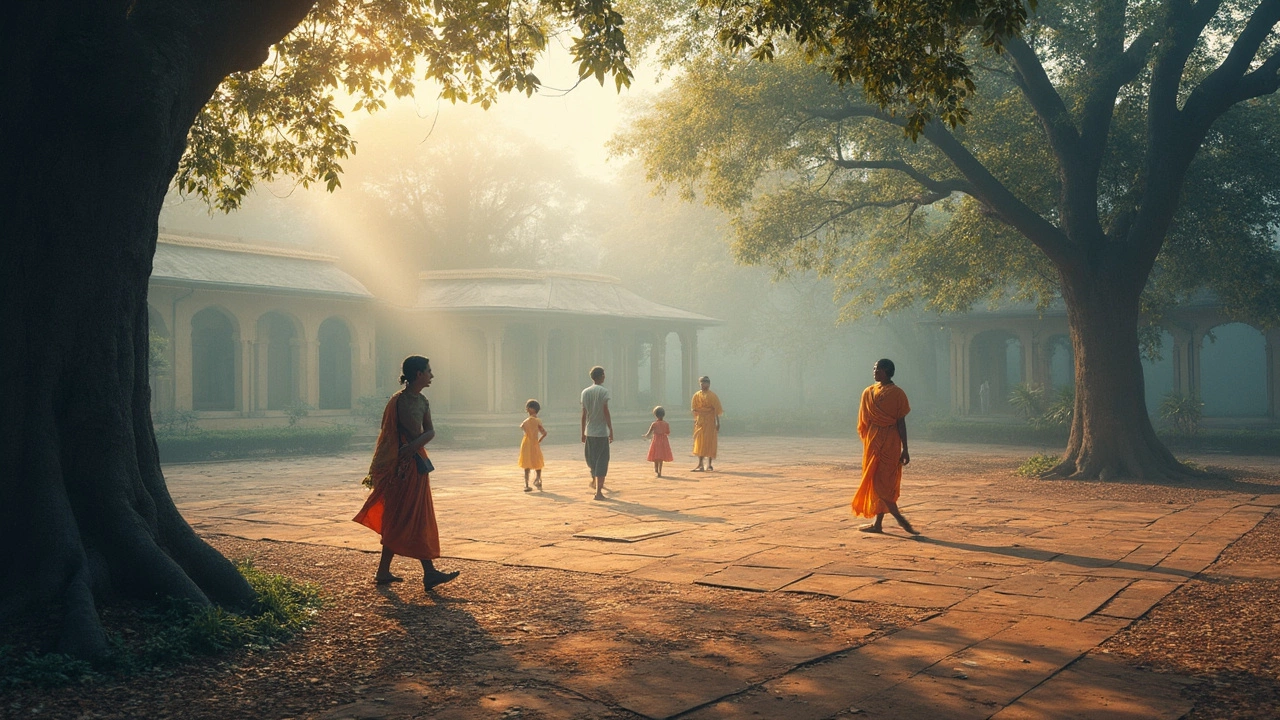Is Shantiniketan a World Heritage Site? Find Out the Real Deal
 Jun, 13 2025
Jun, 13 2025
Shantiniketan isn’t your typical historical spot with grand palaces or sprawling forts. It's basically a university town, but not just any university—the place is the brainchild of Rabindranath Tagore, the Nobel-winning poet. Imagine a small town in West Bengal, surrounded by groves and red earth, bustling not just with students but with some serious art, culture, and real-world learning. That’s the vibe here.
But here’s what everyone’s been asking: Is Shantiniketan officially a UNESCO World Heritage site yet, or is it just talked about like one? In 2023, Shantiniketan finally bagged the title after years of paperwork and hope. So yes, it’s now counted among sites like the Taj Mahal and Jaipur City in UNESCO’s list. This is a big deal, not only for India but for anyone who cares about art, open learning, and innovation outside the usual borders.
- Shantiniketan and Its Roots
- The UNESCO World Heritage Status
- What Makes Shantiniketan Special
- Visiting Tips and What to Expect
- How Heritage Status Changes Everything
Shantiniketan and Its Roots
Here’s the story behind Shantiniketan: The place actually means “abode of peace.” It was started way back in 1863 when Debendranath Tagore, father of Rabindranath Tagore, bought the land for a spiritual retreat. But the real game changer came with Rabindranath. In 1901, he set up a small school here, which didn’t look or feel anything like the usual classrooms. Think open-air classes under the trees, no walls, just learning right in the middle of nature.
The school, called Patha Bhavana, focused on creativity and a personal bond between teacher and student. By 1921, it had grown into Visva-Bharati University. This university is what put Shantiniketan on the map. Visva-Bharati’s whole vibe was about mixing global ideas and local culture, long before the internet made it cool. So you’d see international scholars and artists hanging out with Indian thinkers.
- Visva-Bharati became a central hub for art, music, and social reform in the early 20th century.
- Rabindranath Tagore won the Nobel Prize for Literature in 1913 while working from here—no small feat.
- The campus includes museums, art galleries, and archives holding tons of rare manuscripts and paintings.
You’ll spot some unusual sights here: traditional mud houses, murals by famous artists like Nandalal Bose, and sculptures scattered across the grounds. Shantiniketan really mixes education, culture, and environment in a way that’s still hard to find elsewhere.
| Year | Milestone |
|---|---|
| 1863 | Land purchased by Debendranath Tagore |
| 1901 | School (Patha Bhavana) established |
| 1913 | Rabindranath Tagore wins Nobel Prize |
| 1921 | Visva-Bharati University founded |
So when you hear “Shantiniketan,” you’re not just talking about a university. It’s a symbol of open thinking, creativity, and a mix of world cultures, right out of rural Bengal.
The UNESCO World Heritage Status
If you’re wondering whether Shantiniketan made it to the global big leagues, let’s clear it up: Yes, Shantiniketan was officially added to the UNESCO World Heritage list in September 2023. This move didn’t just happen overnight. It was a long road, filled with back-and-forths, government proposals, cultural documentation, and lots of paperwork. The Indian government had pitched Shantiniketan multiple times, but it finally got the green light after global experts agreed it’s totally unique.
The main reason? Shantiniketan breaks tradition in Indian education and culture. Tagore’s idea of open-air classrooms, creative freedom, and blending the arts with learning was way ahead of its time. UNESCO’s World Heritage site tag is given only to spots with “outstanding universal value.” The panel saw that Shantiniketan isn’t just a school—it’s a symbol of experimental education and global thinking, where ideas from all over the world were welcomed.
Getting this status brings real perks. It means international support for preserving the site, access to funding, and more tourists who want to experience this one-of-a-kind place. Plus, it puts Shantiniketan next to famous Indian sites like the Taj Mahal and Humayun’s Tomb, rocking its name on the global cultural map.
- Application submitted: 2010 (with updates over the years)
- Recognized as UNESCO World Heritage Site: September 2023
- Location: Bolpur, West Bengal, India
- Main reason for selection: Unique approach to education and culture
If you like numbers, here are some stats about Shantiniketan’s big achievement compared to other Indian sites:
| UNESCO Site | Year Listed | Location | Main Feature |
|---|---|---|---|
| Shantiniketan | 2023 | West Bengal | Innovative education/culture hub |
| Taj Mahal | 1983 | Uttar Pradesh | Mughal architecture |
| Jaipur City | 2019 | Rajasthan | Planned city layout |
| Sun Temple, Konârak | 1984 | Odisha | Orissan Hindu temple |
So, visiting here isn’t just about checking out another college or museum; you’re stepping into a spot that’s now protected and celebrated around the world for what it stands for.

What Makes Shantiniketan Special
Most places in India tagged as heritage sites are all about grand old buildings, but Shantiniketan flips that script. The whole town is wired around the idea of open learning. Rabindranath Tagore started Visva-Bharati University here back in 1921. Instead of chalk-and-talk classrooms, he wanted students to learn outdoors, under the trees. Even today, you’ll catch classes happening in the open, which is something you won’t find at other universities.
What sets Shantiniketan apart isn’t just the Nobel Prize history, but the culture mashup. The place draws in artists, musicians, and thinkers from all over. It’s famous for big cultural festivals like Poush Mela and Basanta Utsav. During these, you’ll see locals and tourists dancing, singing, and selling everything from handmade crafts to experimental art.
When UNESCO gave it the World Heritage Site stamp, they pointed at its unique blend of education and culture, openness to the world, and Tagore’s vision of harmony between people and nature. Architecturally, it’s a mix of mud houses, local materials, open-air classes, and structures like the Kala Bhavana (art school). Nothing here screams ‘typical Indian monument’, but it leaves a deep impact.
Check out some quick facts on what makes Shantiniketan tick:
| Fact | Details |
|---|---|
| Founded by | Rabindranath Tagore (Nobel Laureate) |
| University Established | 1921 (Visva-Bharati University) |
| Key Festivals | Poush Mela, Basanta Utsav |
| UNESCO Status Year | 2023 |
| Main Language Influence | Bengali, Santali, international students too |
| Unique Feature | Open-air classes and fusion of global cultures |
You don’t just visit Shantiniketan for old buildings—you come for the vibe, the fusion of ideas, and that laid-back yet brainy atmosphere. For anyone bored of the usual touristy stuff, this place is a fresh rethink, with plenty of stories and surprises tucked into daily life.
Visiting Tips and What to Expect
If you’re feeling curious about this place now that it’s a Shantiniketan UNESCO World Heritage site, you might be wondering what to actually do there. Shantiniketan isn’t your regular tourist trap, so your visit will feel way more personal and chill compared to big city destinations.
First off, the best time to visit is from late November through February. The weather hits that sweet spot—cool, dry, and perfect for long walks around campus or checking out local art fairs. Summer, on the other hand, gets sweltering and the monsoon can be super muggy.
Key sites you shouldn’t miss? There’s Tagore’s Ashram, a cluster of simple, historic buildings including his house and study. Then you’ve got the Visva-Bharati University campus, which feels more like a leafy open museum than a classroom setting. The Kala Bhavana section is amazing for art lovers—think sculpture in the open, fresh murals, and students casually sketching in the shade.
- If you’re into shopping, the Saturday Haat offers craftwork, batik prints, and jewelry made by local artisans—prices are usually negotiable.
- Plan for at least 2 days if you want to soak in the vibe without rushing.
- Photography is allowed almost everywhere, but always check at museum-type spots before snapping away.
Traveling inside Shantiniketan is easy—you can walk, rent a cycle, or hop into a cycle rickshaw. Wear comfy shoes; you’ll do a lot of walking.
Festivals are a big deal here, especially Poush Mela (usually in December) and Basanta Utsav (Holi, sometime in March). If you’re there during these, expect plenty of music, folk dance, and food stalls. It does get crowded though, so plan your stay in advance. Hotels fill up fast during festival seasons, and rates go up accordingly.
| Travel Fact | Details |
|---|---|
| Best Months to Visit | November to February |
| Local Languages | Bengali, English, Hindi |
| Recommended Stay | 2-3 days |
| Average Daily Budget | ₹1500–₹2500 per person |
No need for fancy guided tours unless you want them—local students often offer spontaneous, affordable walks for a real insider’s look. Also, don’t skip the open-air classes and performances if you can catch them. They really show what Shantiniketan is all about. Cash is king here, though some spots accept UPI and cards. ATMs are around but can run out of cash during major events, so plan ahead.

How Heritage Status Changes Everything
Getting tagged as a world heritage site isn’t just about bragging rights. For Shantiniketan, it means a whole wave of new stuff—some awesome, some challenging. As soon as UNESCO put it on the list in 2023, there was a spike in interest from people all over India and even a steady trickle of foreign travelers. That’s real visibility for a quiet place that mostly drew artists and dreamers.
Heritage status means extra protection comes in. The Indian government and local authorities now have to take conservation way more seriously. There's funding for repairs, checks to stop dodgy construction around historic buildings, and more attention to keeping the vibe authentic. Roads got fixed up, security improved, and the local economy started to benefit from tourism money flowing in. Hotels, cafes, and guides have seen more work, which has created jobs for the community.
But it’s not just about money or maintenance. With so many eyes now on Shantiniketan, there's real pressure to keep the experience genuine. UNESCO checks whether rules are followed—like not setting up flashy modern stuff that spoils the feel or messing with Tagore’s vision of education. They’re pretty strict about that. The folks running Visva-Bharati University needed to work together more with cultural groups and conservationists to balance tradition with the needs of students and visitors.
One bonus: international recognition makes it easier for researchers and scholars to get grants and support from global organizations. You’ll see more artists, writers, and academics wanting to study or create right here, adding to the creative buzz.
Of course, there’s a flip side—tourism can mean more crowds, which sometimes makes locals worry about noise or pollution. But the focus on heritage usually means rules are enforced, and people are reminded about respect for the environment and culture.
Bottom line: Shantiniketan’s UNESCO status isn’t just a badge. It’s reshaped everything—from the look of the town to how it works, who visits, and how its story is told to the world.